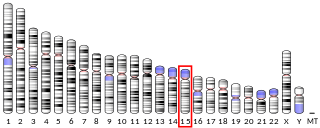
Thyroxine 5-deiodinase also known as type III iodothyronine deiodinase (EC number 1.21.99.3) is an enzyme that in humans is encoded by the DIO3 gene. This enzyme catalyses the following chemical reaction

Glutathione peroxidase 1, also known as GPx1, is an enzyme that in humans is encoded by the GPX1 gene on chromosome 3. This gene encodes a member of the glutathione peroxidase family. Glutathione peroxidase functions in the detoxification of hydrogen peroxide, and is one of the most important antioxidant enzymes in humans.

Selenoprotein P is a protein that in humans is encoded by the SEPP1 gene.

Selenoprotein S, also known as SELS, is a human gene.

Selenide, water dikinase 1 is an enzyme that in humans is encoded by the SEPHS1 gene.

Selenoprotein N is a protein that in humans is encoded by the SEPN1 gene.

SECIS-binding protein 2 is a protein that in humans is encoded by the SECISBP2 gene.

15 kDa selenoprotein is a protein that in humans is encoded by the SEP15 gene. Two alternatively spliced transcript variants encoding distinct isoforms have been found for this gene.

Sperm mitochondrial-associated cysteine-rich protein is a protein that in humans is encoded by the SMCP gene.

Selenoprotein W is a protein that in humans is encoded by the SEPW1 gene.

Hairy/enhancer-of-split related with YRPW motif-like protein is a protein that in humans is encoded by the HEYL gene.

Tribbles homolog 2 is an atypical protein kinase that is encoded in human by the TRIB2 gene. TRIB2 is a pseudokinase member of the (pseudoenzyme) class of signaling/scaffold proteins, possessing very low vestigial catalytic output in vitro and critical scaffolding signaling functions in cells. It is known to signal to canonical MAPK and AKT pathways and to regulate the ubiquitination of substrates with important functions in cell proliferation that control the cell ccyle. It has also been associated with various diseases, especially in human and murine blood and solid tumor models. Like TRIB1 and TRIB3, TRIB2 has recently been considered as a potential allosteric drug target, and its three dimensional structure has been solved with the aid of stabilizing nanobodies corroborating the potential for new approaches for drug targeting outside the highly degraded ATP site and is a putative regulator of cancer-associated signalling and survival through AKT pSer473 modulation. Recent work has established a convincing link between targetable overexpression of TRIB2 and prostate cancer drug responses

Methionine-R-sulfoxide reductase B1 is an enzyme that in humans is encoded by the SEPX1 gene.

Thioredoxin reductase 1, cytoplasmic is an enzyme that in humans is encoded by the TXNRD1 gene.

Type II iodothyronine deiodinase is an enzyme that in humans is encoded by the DIO2 gene.

Selenoprotein T, also known as SELT, is a protein that in humans is encoded by the SELT gene.

Glutathione peroxidase 3 (GPx-3), also known as plasma glutathione peroxidase (GPx-P) or extracellular glutathione peroxidase is an enzyme that in humans is encoded by the GPX3 gene.

Glutathione peroxidase 6 (GPx-6) is an enzyme that in humans is encoded by the GPX6 gene.

Mitochondrial translational release factor 1-like is a protein that in humans is encoded by the MTRF1L gene.

Ribosome-releasing factor 2, mitochondrial is a protein that in humans is encoded by the GFM2 gene. Unlike the other EF-G homolog GFM1, GFM2 functions as a Ribosome Recycling Factor in termination.

















